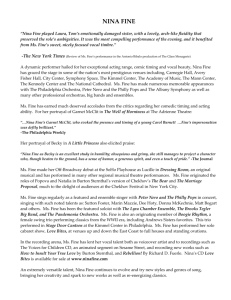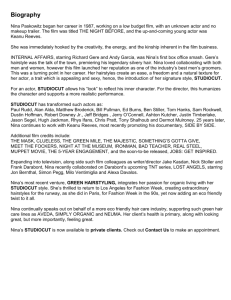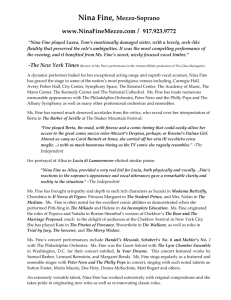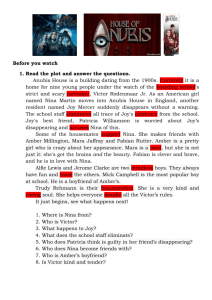Do we assume you know the characters
advertisement
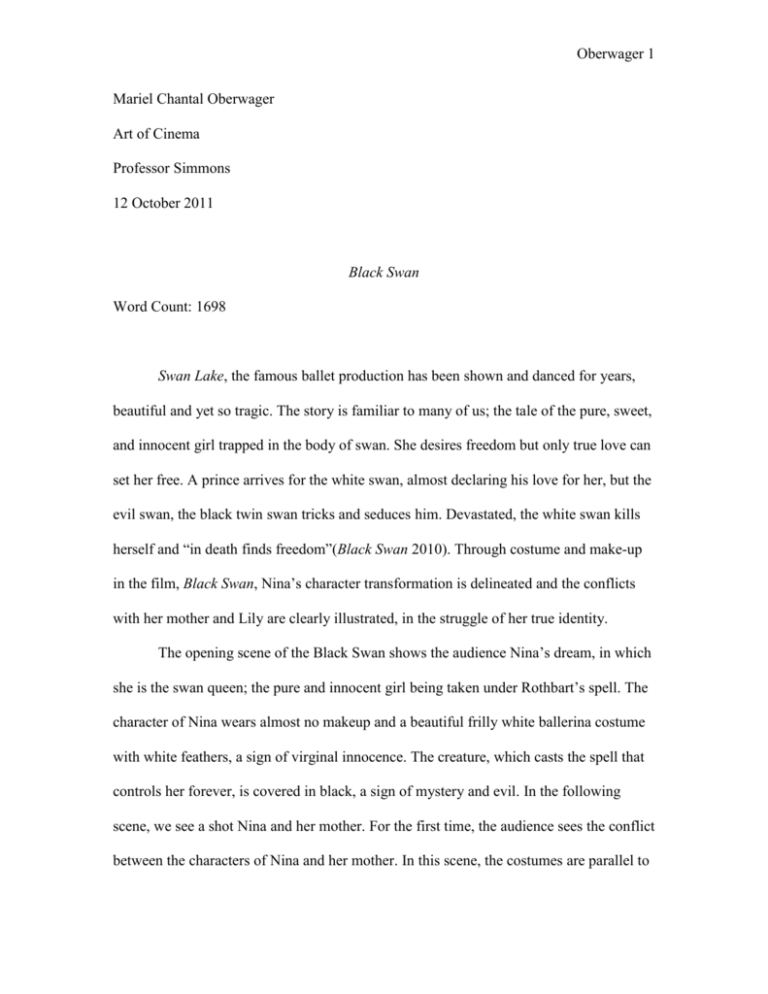
Oberwager 1 Mariel Chantal Oberwager Art of Cinema Professor Simmons 12 October 2011 Black Swan Word Count: 1698 Swan Lake, the famous ballet production has been shown and danced for years, beautiful and yet so tragic. The story is familiar to many of us; the tale of the pure, sweet, and innocent girl trapped in the body of swan. She desires freedom but only true love can set her free. A prince arrives for the white swan, almost declaring his love for her, but the evil swan, the black twin swan tricks and seduces him. Devastated, the white swan kills herself and “in death finds freedom”(Black Swan 2010). Through costume and make-up in the film, Black Swan, Nina’s character transformation is delineated and the conflicts with her mother and Lily are clearly illustrated, in the struggle of her true identity. The opening scene of the Black Swan shows the audience Nina’s dream, in which she is the swan queen; the pure and innocent girl being taken under Rothbart’s spell. The character of Nina wears almost no makeup and a beautiful frilly white ballerina costume with white feathers, a sign of virginal innocence. The creature, which casts the spell that controls her forever, is covered in black, a sign of mystery and evil. In the following scene, we see a shot Nina and her mother. For the first time, the audience sees the conflict between the characters of Nina and her mother. In this scene, the costumes are parallel to Oberwager 2 that of the earlier swan lake scene; the mother wears all black while Nina wears tones of pink and white. Abstractly, it can be inferred that Rothbart is compared to Nina’s mother, while the Swan queen is Nina herself. In casting the spell, Rothbart is able to control the swan queen. Nina’s mother controls Nina’s life; every plie in her perfect ballerina life is carefully constructed by her mother who never realized her own ballerina dreams. Nina’s room in her mother’s house is the only warm room in the film, covered and suffocating in pink, light greens and childish stuffed animals. There is never any suggestion of a grown up independent Nina, (at the beginning of the film) and much of it is due to the costumes worn by Nina and her mother; Nina in pink, while her mother wears black. Nina is trapped in a child’s lifestyle unable to make the decisions for her self, and ultimately having to depend on her mother for everything. What may seem perfect on the outside, (Nina’s perfection in the ballet, her tones of sweet pink and white), are actually a plea for help, a plea that can be seen through hers and other character’s costumes. Nina is ensnared by her mother and as long as she lets her control her life she will always feel trapped. As the film progresses and Nina begins to wear gray and her character changes as well; she is more in control of her life. Through the help of other characters she begins to realize how controlled her life is. Nina becomes more aggressive towards her mother, not letting her know or do things about her life. The conflict between her and her mother arises. She even goes as far as to throw away the stuffed animals in her room, a clear reminder of the childish treatment she receives. As she becomes more aware of this control the shades of her costumes change as well. From pink to black and gray, Nina’s costume changes because she is more serious about her relationship with her mother. Her Oberwager 3 mother slowly loses more and more control and this is clearly illustrated through the costumes. Nina’s transition, into the black swan, with the help of Lily, frees her by letting her go out of her perfect comfort zone of that of the white swan. The first time Nina sees Lily, the rival ballerina, she thinks she is actually seeing herself. Lily serves as a parallel to Nina; they have very similar physical features and yet in the beginning Lily is the one always wearing dark gray colors. In this sense, the costumes reinforce the idea that at the beginning, Nina is the white swan and Lily is her evil black swan twin. Another example of the contrast in their costumes is in the gala scene. In the first presentation of the new Swan Queen at the gala, Nina wears a white gown, while Lily wears a black gown where her black wings tattoo on her back is also visible. The tattoo that is created on Lily’s back is also symbolic to her character, the other swan, the evil one, the one Nina is wary of. Her makeup is darker around her eyes signifying some sort of mystery. The specific make-up worn by Lily through the tattoo and the actual face make-up also signals to the audience the threat that will be posed to Nina through Lily. The ballet company also serves to reiterate certain character traits through costume. In the group practices, before Nina is chosen as the swan queen, all the dancers are wearing gray and black except for Nina; she wears all pink and white. The rehearsal room also helps with the tone of the film; most rooms are black with large mirrors. This makes it even easier for Nina to stand out with her light tones. Hair is also another way costume affected the character conflict between Nina and Lily. Most ballerinas, Like Nina, wear buns. The skull tight buns signify the strict discipline Nina goes through everyday with her mother and the way she pushes herself in the ballet. In contrast, Lily Oberwager 4 wears her hair loose most of the time, signifying to the audience that she is free willed; nothing and no one is holding her back. Although it seems as if Nina is competing against Lily, and against her mother, in reality she is battling herself and her own identity. Nina goes through a transformation in character that is clearly portrayed through costume and makeup. In the beginning of the film, as mentioned earlier, Nina is portrayed with strictly white and pink tones; even the color of her cell phone is pink. These colors symbolize the strict dependency she has on her mother and being perfect. Her obsession with being perfect leads her to want to embody someone one else, someone like Beth, the prior swan queen. In one scene, Nina steals Beth’s lipstick in order to feel closer to becoming the white swan. In wearing the rouge lipstick she feels closer to perfection. When Beth asks her why she stole her belongings she simply replies, “I just want to be perfect” (Black Swan 2010). As the film progresses, Nina’s character changes as well, she is more in control of her life. She is able to confront Lily about what is bothering her, speaking up for the first time. She also becomes more aggressive towards her mother, not letting her do everything for her and closing her out more and more. She goes as far as to sneak out of her own house, disobeying her mother, to go out with Lily. Nina slowly begins to wear more gray tones going further from pink in each scene. Color scheme is central to Nina and other characters, Amy Westcott, the film’s costume director, “used the palette to show the evolution of Nina’s character, and the awaking of her sexuality” (Westcott). When Nina has her first sexual encounter with Leroy, the ballet teacher, she is wearing gray, rose colors are no longer that primary. The costumes used at the ballet rehearsals are also pivotal to the transformation. Westcott also comments that, “Rehearsal costumes Oberwager 5 were an intentional color mix, mainly blacks, greys and blues for Lilly (Kunis); pinks and white for Nina (Portman). These colour schemes gradually blend together towards the end of the story” (Westcott). Indeed, Nina’s colors end up blending with that of Lily’s symbolizing her transition into a black swan, her innocence slowly fading. On the night Nina goes out with Lily she wears black for the first time under a gray sweater. When Nina does ecstasy, we see a glimpse as her as the black swan for the first time. For a split second, Nina’s makeup resembles that of the black swan signifying to us the process of her transformation into the black swan. This color change also illustrates the shifting of her unsteady personality; the line between reality and imagination has become a blur. In the scene where Nina wears black tights for the first time, Nina’s reflection in the mirror is altered and unreal. When finally performing the black swan, special effect make-up is used as Nina pulls actual black feathers from her back. She is no longer the innocent pure sweet Nina, she has killed that side of her. Nina realizes she has jumped the fence to the other side of her self. Through costume and make-up, the film Black Swan, shows us the conflicts between Nina, her mother, and Lily. The color change from beginning to end also clearly illustrates the transformation of Nina’s character. Nina goes from wearing pink to gray to black, finally becoming the black swan, the exact contrast of the perfection she used to strive for. Nina has conflicts with Lily, shown through the opposite colors they wear; black for Lily and white for Nina. Lily has what Nina wants; the freedom to express herself. There is also a clear contrast between Nina and her mother. Nina wears pink at the beginning of the film because she is still being controlled like a sweet innocent child. As the film progresses she starts wearing colors more similar to her mother’s, her mother Oberwager 6 is no longer controlling her. Nina transforms herself psychologically in order to search her true identity. She literally has to kill the sweet innocent pure white swan inside her to effectively become the free black swan. And in death, Nina finds freedom and perfection. Work Cited Oberwager 7 Laverty, Chris. "Black Swan: Amy Westcott Interview | Clothes on Film." Clothes on Film | Screen Style & Identity. Clothes On Film, 28 Jan. 2011. Web. 10 Oct. 2011. <http://clothesonfilm.com/black-swan-amy-westcott-interview/18997/>.

